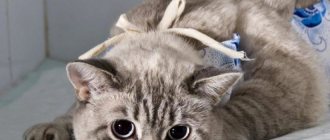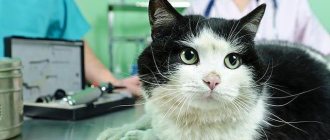Sterilization of cats is a surgical procedure that involves the removal of reproductive organs, which leads to loss of reproductive function and the cessation of external manifestations of sexual desire. Such a radical procedure is often resorted to by owners of domestic cats who do not want to bother with their offspring.
Sterilization is carried out by experienced doctors in a veterinary clinic. After such a procedure, the animal must be properly cared for, which will eliminate possible postoperative complications.
In the article we will talk about the features of caring for a cat after sterilization, how to treat sutures, when to remove the blanket, how to feed it properly, when you can drink water, after how many days the animal can be washed, why a cat should not jump, and what else is unacceptable to do after surgery.
When can you remove the blanket?
A bandage (blanket) tied on the back is used to protect the sutures on the abdomen placed in the clinic during surgery.
The healing period of the suture is extremely important for the future health of the cat.
Sometimes it is possible to remove the blanket from a cat after sterilization already on the second day after the operation, but if emergency situations arise, the period of wearing the bandage can increase to 10 days or more.
The main problem when wearing a protective device can be considered that the tailed pet protests with all his might against putting it on , tries to get rid of it, seems very unhappy, which causes the owner a natural desire to make the cat’s life easier.
But there are a number of nuances that affect the period of wearing the bandage.
Types of cat sterilization
Caring for your cat after surgery depends on the type of sterilization and anesthesia. To eliminate reproductive function, 3 methods are used:
- Tube sterilization
. The animal's fallopian tubes are ligated. This prevents further reproduction, but preserves sexual desire and estrus. The method is used less and less, as it retains the risk of inflammation and oncology of the genital organs.
- Ovariotomy
. The surgeon removes the ovaries but leaves the uterus. The operated patient stops estrus, but the risk of uterine disease remains.
- Ovariohysterectomy
. The safest and most effective method, which involves the removal of all internal genital organs. The risk of developing cancer is completely eliminated.
The operation itself takes less than an hour.
The rest of the time is spent recovering from anesthesia. There are 3 options for waking up:
- Immediately after the anesthesia is turned off. Characteristic of gas anesthesia, which puts the patient into a sedative state. Despite its low toxicity, it is used only in a limited number of veterinary clinics due to a lack of equipment and medicinal substances.
- Within 8 hours. A combination of epidural anesthesia and muscle relaxants. It is also low-toxic, but requires a lot of experience from the surgeon. An error when working with an animal's spine can lead to loss of sensitivity in its paws for up to 2 days.
- Within 5-24 hours. The most common method is the use of analgesics and muscle relaxants. This type of anesthesia is the most severe, so the pet can recover from it for almost the whole day.
Under general anesthesia, the animal's reproductive organs are removed using a scalpel or endoscopic equipment and stitches are placed. Caring for them depends on their type.
What affects the duration of wearing a blanket?
The number of days directly depends on the method in which the postoperative sutures were processed.
Types of processing:
- Using a protective spray. This method of treating a postoperative suture protects the wound from the development of inflammatory processes, accelerates the healing process, has a beneficial effect on overall well-being, and reduces the period of wearing protection to 7 days.
- Without using protective spray. In this case, we are talking about a time interval from a week to 10 days, it all depends on the condition of the animal and the speed of healing of the skin.
Be sure to read:
A cat has a lump on her stomach after sterilization: reasons for the appearance of ours and under the suture, what to do, prevention
The protective bandage is made from natural fabrics (cotton), does not irritate the animal’s skin, does not allow the cat to lick the wound, protects against inflammation of the seam, but causes some discomfort to the pet.
Your furry pet may notice changes in behavior or gait, but as soon as the protection is removed, everything will be restored.
Important! Many owners independently decide when to remove the blanket after surgery, based on the fact that the cat is hampered by the protective bandage. If the bandage is removed without the advice of a veterinarian, it is necessary to constantly monitor the pet. You can use a special collar that will prevent the animal from licking the seam.
Care: first week day by day
Day 1
After surgery, the cat sleeps an additional 30 minutes to 1-1.5 hours. On the first day the animal is half asleep and lethargic. There is a lack of coordination of movements. There may be hallucinations. Do not give any drugs that speed up recovery from anesthesia without the consent of your veterinarian! For the first 24 hours, you need to be nearby, pet the animal, hold it in your arms, and observe. When leaving, it is better to leave the cat in a small enclosed space and on the floor to avoid it falling and leaving in an unknown direction. Do not provide food or water - there is no need to feed the baby at all during the first day; you need to give it drips from a syringe or pipette.
If there is no blinking, close the cat's eyes yourself to prevent the cornea from drying out. Do this before you start blinking on your own.
On the first day, the animal is disoriented - it can run away in an unknown direction, stop abruptly, run into walls, meow, fall and fall asleep, jump up, etc. There is no need to be afraid. It is better to place your pet in a non-passable room so that no one or anything can disturb it. Possible involuntary urination. If your cat goes to the toilet on her own, you can support her by placing a full-width towel under her belly for stability and additional bowel stimulation.
There is vomiting. The first sign of gagging is excessive licking of the face. You should not bathe until the stitch heals.
If the cat is in pain, it needs an anesthetic injection, previously prescribed by a veterinarian.
Day 2
The cat gradually comes to its senses and becomes more adequate. You can put water near it and start feeding it a little. The food starts with low-fat chicken broth or kefir with bifidobacteria. Do not overfeed under any circumstances, but give all food in small portions. Only water should be freely available and in plenty! Even if before the operation the cat was only on dry food, you should not start with it - it is better to replace it with similar “wet” ones.
If the animal moves little and the paws are cool, you need to rub them or put the cat on a warm heating pad, promptly removing the cold one. On the second day, she can hide from prying eyes - you must make sure that the animal is always in sight. If you are allowed to hide, then in places where you can easily get it.
The cat's toilet should be somewhere nearby so as not to bother the animal with unnecessary walking after surgery.
If a cat does not walk at all after sterilization, then there are two reasons: the animal is uncomfortable in the bandage or there are problems with the hind limbs after anesthesia (especially after epidural anesthesia). The exact cause will be determined by a veterinarian who can be invited to your home.
Continue to monitor behavior, appetite, urination, bowel movements (should have already appeared) and general condition.
Usually the pain goes away on the second day. If there are still signs of discomfort due to pain, a painkiller is given or injected.
Day 3
On the 3rd day, the cat should fully come to its senses: show activity and interest in what is happening, go to its litter box and start asking for food. You can gradually switch to a regular diet, but the ban on overfeeding remains.
On this day, it is necessary to measure your body temperature. Body temperature is measured rectally (in the rectum) with the tip of a thermometer lubricated with Vaseline or any greasy cream. If the temperature is elevated by two measurements during the day, you need to contact your veterinarian - you may have to start taking antibiotics. The course will have to be completed in full, regardless of which day the temperature drops to normal.
If the temperature does not begin to decrease from antibiotics, you need to take the cat to a veterinarian or call him at home - there is a risk that the infection is viral, and this is a risk of death of the animal due to post-operative weakness.
Also a reason to contact a veterinarian if the body temperature is below 37.5°C.
If there is no bowel movement, you can give mild laxatives based on lactulose (Lactusan, Duphalac). The intestines must be emptied regularly - this must be monitored, because... very often after anesthesia there is a slowdown in intestinal motility.
Day 4
By the fourth day, the animal should actively and independently eat and drink, active urination and bowel movements should be noted.
If there is no urination, you need to give 1/5 tablet of no-shpa or 2-3 drops of valerian tincture diluted in a teaspoon of water. After 15 minutes, do a light abdominal massage at the level of the bladder. Urination should appear. If still not, the cat needs to be taken to a veterinary hospital for bladder catheterization.
Day 5
By the fifth day, you can start letting the cat out of the closed room, because... She can be allowed some activity - walk relatively long distances (between rooms); she can be allowed to walk in the yard (under supervision) if the animal had access to the street before sterilization. You can jump on low surfaces.
By the fifth day, the swelling and redness around the suture should subside, if there were any such signs. Signs of scarring should appear.
Day 6 and 7
The only reminders that the cat has undergone surgery are the blanket (bandage) and the presence of postoperative sutures. By the end of the week, the animal should be fully active, eat with appetite, drink when it wants, sleep in any chosen place, jumping onto the sofa or chairs (it is, of course, still difficult to jump onto the windowsill from the floor).
No pain. Urinate and have bowel movements as usual. If the body's resistance is normal, the sutures can be removed on the 7th day - maximum on the 10th.
The suture after sterilization of a cat should be clean, dry, with signs of dense scarring, without signs of inflammation or suppuration.
When is it possible to remove the protective device early?
The protective bandage is made from natural fabrics (cotton) and does not irritate the animal’s skin
. Early removal is possible if:
- the surgical intervention was carried out using laparoscopy: in this case, the wound is so small that protection is not required;
- when performing sterilization, the surgeon used absorbable suture material and protective sprays to treat the wound;
- Four days after the operation, the cat has a normal body temperature, there is no bleeding, redness of the suture, or suppuration.
Important! When using suture material that requires further removal, you should not remove the bandage ahead of time, even if it causes discomfort to the animal.
After examining your pet, the doctor may recommend getting rid of the protective accessory ahead of schedule if:
- aggression is clearly expressed, the animal continuously tears off and gnaws the blanket;
- the animal is afraid to walk in a bandage;
- ulcerations appeared under the places where the tissue puts maximum pressure on the body;
- the bandage became very dirty due to eating and visiting the toilet.
Do's, Don'ts and Don'ts
Need to:
- monitor the condition of the blanket (bandage) - cleanliness, integrity and general comfort;
- continue to treat the cat for blood-sucking parasites, monitor the condition of the ears and schedule anthelmintic. The body, weakened by surgical intervention, has poor resistance to internal and external parasites;
- monitor your diet to avoid the development of constipation, and also reduce food portions than before the operation. Enhanced feeding or voluntary feeding can trigger the development of obesity. Neutered cats should consume almost a quarter less food.
Can:
- carefully pick up the animal in your arms, picking it up under the front and hind legs, without putting pressure on the stomach;
- take him for short walks under supervision;
- water as much as the cat wants;
- feed with special food for sterilized cats.
It is forbidden:
- allow the cat to bask on warm radiators and heaters after surgery;
- pick up the cat in your arms for a month, picking it up only by the front paws;
- smear the seams with any alcohol-containing substances (iodine, brilliant green, chloramphenicol, etc.) - there is a high probability of burns;
- leave food in the morning for the whole day (especially in the summer). Food should be left out for 15-20 minutes in the morning and for the same amount in the evening to eliminate the possibility of overeating or poisoning from souring;
- remove the blanket until the stitches are completely healed;
- actively play with the cat and jump in the first two weeks.
Sterilization (castration) is not a complicated operation, the difficulty lies in the postoperative period. After surgery, you should definitely get recommendations from your veterinarian on how to care for your cat and strictly adhere to them. In any emergency situation, you must consult a specialist.
Author:
Grinchuk Ekaterina Andreevna veterinarian
Observation after removal of the bandage
After the bandage is removed, it is necessary to carefully monitor the cat's condition in the first days. The cat family is characterized by increased cleanliness, therefore, at first the animal will constantly lick the seam.
The owner must ensure that the cat does not chew the edges of the healed wound.
Be sure to read:
After sterilization, a cat sleeps a lot and is lethargic: normal or pathological, what consequences may occur after surgery
Important points during inspection:
- monitor the integrity of the edges of the wound surface;
- control whether there is any discharge from the wound in the form of blood or lymph;
- inspect the seam for redness, inflammation, and the appearance of purulent discharge;
- check whether nodes or swellings have appeared along the edges of the wound surface.
Any of the identified anomalies is a reason for an unscheduled visit to the veterinarian.
What to do if the cat removed the stitches on its own?
The situation when the cat removed the stitches itself is not uncommon in veterinary practice. Unfortunately, nothing good should be expected from such initiative, but there is still a chance for a successful outcome. They increase if the animal has its stitches removed closer to the date of their “official” removal.
If this happened in the first days after the operation, then the owner does not have much choice: he needs to urgently call the veterinarian.
The following signs indicate a high probability of severe complications:
- Heavy bleeding.
- Torn, torn edges of a postoperative wound.
- Easily visible internal organs visible through the disturbed wound channel.
Let us repeat once again - in such cases you need to immediately call a veterinarian. If the bleeding is severe, it is necessary to take the cat to the nearest clinic, but we would recommend waiting for a specialist at home. Transporting a cat with such injuries is very dangerous, and the pet may simply not survive until medical attention is provided.
Processing and removal of seams
The sterilization operation is carried out under anesthesia; the owner needs not only to properly remove the animal from this state (properly contain, feed, give water), but also take care of the cleanliness of the wound.
The procedure for treating sutures begins on the third day after sterilization
The procedure for treating sutures begins on the third day after sterilization, at intervals of 2 times a day.
Algorithm of actions:
- Calm the beast, remove the bandage.
- Use a cotton swab soaked in an antiseptic (without alcohol) to generously moisten the wound surface with gentle movements.
- Remove hairs and dried blood.
- Inspect for inflammatory processes.
- Put on a bandage.
Attention! In some cases, to speed up healing, cat owners apply iodine or brilliant green to the stitches. It is strictly not recommended to do this: the drugs dry out the edges of the wound, inhibit recovery processes, and can lead to chemical burns of the skin.
Safety precautions for the pet owner
During the procedure, the owner should worry not only about the safety of his pet. The health of the person undergoing the suture removal procedure may also be at risk. This is due to the fact that cats are rarely delighted with the fact that someone is “poking” their skin with tongs.
As a rule, removing stitches is not the most pleasant procedure; severe discomfort is possible. To minimize the likelihood that your pet will tear your hands until they bleed, you need to take the following steps:
If possible, call your veterinarian. The specialist may recommend some mild sedatives. Under their influence, the animal will become calmer, and therefore it will be easier for the owner to cope with it.
Please note that cat sterilization itself can be carried out using the same medications. If you reintroduce them a few days after the operation, the animal’s body will have a very hard time (the so-called cumulative effect will play a role). Thus, in this case it is necessary to select other sedatives. This will avoid unpleasant consequences.
However, you can cope without “chemistry”, but this will require an assistant. Just remember that you will have to hold the animal quite firmly.
Some tips for caring for your cat after surgery
If the animal refuses to let its owner near, fights and breaks out, then you should:
- give the animal sedatives during the recovery period;
- do not show aggression or dissatisfaction with the behavior of the animal, talking affectionately and stroking it;
- carry out the treatment after swaddling the pet with a soft towel.
It is forbidden:
- use alcohol tinctures for processing;
- rub the surgical site;
- Thickly lubricate the seams with a healing agent;
- apply a tight bandage.
Proper care and the presence of blankets are the key to a speedy recovery.











